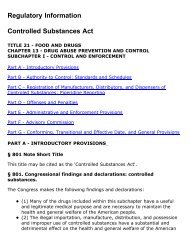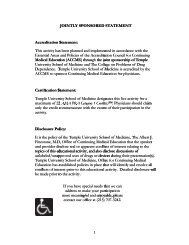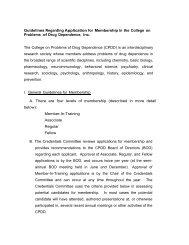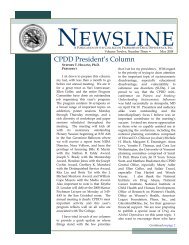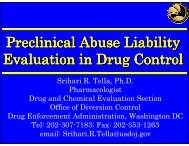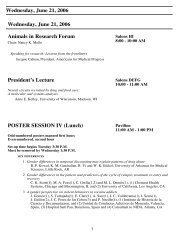CPDD 72nd Annual Meeting • Scottsdale, Arizona - The College on ...
CPDD 72nd Annual Meeting • Scottsdale, Arizona - The College on ...
CPDD 72nd Annual Meeting • Scottsdale, Arizona - The College on ...
Create successful ePaper yourself
Turn your PDF publications into a flip-book with our unique Google optimized e-Paper software.
61<br />
THE RELATIONSHIP BETWEEN SUBSTANCE ABUSE<br />
HALFWAY HOUSES AND CRIME IN BALTIMORE CITY,<br />
MARYLAND.<br />
Susan J Boyd 1 , L J Fang 1 , D R Medoff 1 , L B Dix<strong>on</strong> 1 , D A Gorelick 2 ; 1 Psychiatry,<br />
University of Maryland School of Medicine, Baltimore, MD, 2 Intramural<br />
Research Program, NIDA/NIH/DHHS, Baltimore, MD<br />
Aims: Placement in a substance abuse halfway house has been shown to increase<br />
treatment retenti<strong>on</strong> in substance abuse patients. However, many communities<br />
resist the establishment of halfway houses, at least in part due to c<strong>on</strong>cerns about<br />
crime. Empirical evidence <strong>on</strong> the effect of halfway houses <strong>on</strong> neighborhood<br />
crime is lacking. This study used an innovative “microecologic technique” to<br />
evaluate crime around 9 substance abuse halfway houses in Baltimore City,<br />
Maryland.<br />
Methods: As c<strong>on</strong>trol sites, 9 residential street addresses (residential points) were<br />
matched to the 9 halfway houses based <strong>on</strong> neighborhood crime and sociodemographic<br />
variables. Addresses of halfway houses, residential points, and all<br />
Baltimore City police department crime reports from January 1, 1999 through<br />
December 31, 2001 were “geocoded” (latitude and l<strong>on</strong>gitude assigned by computerized<br />
mapping). C<strong>on</strong>centric circular “buffers” were drawn at 25-meter intervals<br />
up to 300 meters around each site. Parameter estimates generated by Poiss<strong>on</strong><br />
regressi<strong>on</strong> analyses were used to assess the relati<strong>on</strong>ship between crime counts<br />
(incidents per unit area) and distance from the site.<br />
Results: Halfway houses had no relati<strong>on</strong>ship with crimes committed during the<br />
day (7 a.m.-7 p.m.) (parameter estimate -0.1263, p < 0.831) or at night (-<br />
0.1217, p .70 for reliability across alcohol and drug offer<br />
situati<strong>on</strong>s. C<strong>on</strong>tent areas assessed by the A-SIDE correlated with indices of substance-related<br />
cogniti<strong>on</strong>s (i.e., expectancies, motives, coping).<br />
C<strong>on</strong>clusi<strong>on</strong>s: This preliminary investigati<strong>on</strong> suggests that the A-SIDE is a reliable<br />
measure of substance use decisi<strong>on</strong>-making in this sample of youth. While<br />
work is underway to examine the c<strong>on</strong>struct and predictive validity of this measure,<br />
these preliminary findings are encouraging in the development of a processoriented<br />
measure of substance use relapse for youth.<br />
Financial Support: NIDA 019960 (K. Anders<strong>on</strong>)<br />
<str<strong>on</strong>g>CPDD</str<strong>on</strong>g> <str<strong>on</strong>g>72nd</str<strong>on</strong>g> <str<strong>on</strong>g>Annual</str<strong>on</strong>g> <str<strong>on</strong>g>Meeting</str<strong>on</strong>g> <str<strong>on</strong>g>•</str<strong>on</strong>g> <str<strong>on</strong>g>Scottsdale</str<strong>on</strong>g>, <str<strong>on</strong>g>Ariz<strong>on</strong>a</str<strong>on</strong>g><br />
16<br />
62<br />
KUDZU ROOT EXTRACT DOES NOT AFFECT THE<br />
SLEEP/WAKE CYCLE IN MODERATE DRINKERS.<br />
Bethany K Bracken 1,2 , D M Penetar 1,2 , R R Maclean 3 , D Y Lee 1,2 , S E Lukas 1,2 ;<br />
1 McLean Hospital, Belm<strong>on</strong>t, MA, 2 Harvard Med Sch, Belm<strong>on</strong>t, MA, 3 Penn<br />
State, State <str<strong>on</strong>g>College</str<strong>on</strong>g>, PA<br />
Aims: Kudzu root extract has been studied as a treatment for alcohol dependence.<br />
In heavy drinkers kudzu decreases alcohol c<strong>on</strong>sumpti<strong>on</strong> both in a naturalistic<br />
laboratory setting and an outpatient setting. In dependent populati<strong>on</strong>s<br />
sleep disturbances sec<strong>on</strong>dary to alcohol withdrawal may precipitate relapse. In<br />
additi<strong>on</strong>, a number of medicati<strong>on</strong>s used to treat alcohol abuse can impact sleep.<br />
As such, the effect of kudzu <strong>on</strong> sleep quality may be an important factor in its<br />
effectiveness at decreasing alcohol c<strong>on</strong>sumpti<strong>on</strong>. In this double blind, placebo<br />
c<strong>on</strong>trolled crossover trial we tested the effects of kudzu root extract <strong>on</strong> the<br />
sleep/wake cycle of moderate drinkers (7.6±0.6 drinks/week).<br />
Methods: Ten healthy adult (age 28.5±2.2 years) men (n=6) and women (n=4)<br />
took part in each of 3 phases. For 9 days participants were given kudzu (750<br />
mg/day total isoflav<strong>on</strong>es; NPI-031; Alk<strong>on</strong>trol-Herbal®, Natural Pharmacia<br />
Internati<strong>on</strong>al, Inc.) or placebo in counterbalanced order with an intervening no<br />
treatment period of approximately 21 days. Participants kept a daily diary of bedtime<br />
and wake time, and wore a wrist actigraphy device (ActiWatch-Score, Mini-<br />
Mitter/Respir<strong>on</strong>ic) from which sleep parameters were calculated.<br />
Results: <str<strong>on</strong>g>The</str<strong>on</strong>g> following sleep parameters were similar during kudzu (K) and<br />
placebo (P) treatment periods: sleep efficiency index ([K] 79.3±1.5; [P]<br />
79.1±1.6), sleep latency ([K] 28±4min; [P] 31±6min), wake after sleep <strong>on</strong>set<br />
([K] 6hr 23min ± 11min; [P] 6hr 19min ± 11min), number of wake episodes<br />
during the night ([K] 33.5±0.4; [P] 31.5±0.3), and time awake per episode ([K]<br />
1min±7sec; [P] 1min±2sec).<br />
C<strong>on</strong>clusi<strong>on</strong>s: <str<strong>on</strong>g>The</str<strong>on</strong>g>se data suggest that the administrati<strong>on</strong> of kudzu root extract<br />
does not disturb sleep/wake cycles of moderate drinkers and as such its utility as<br />
an adjunct treatment for alcohol dependence remains free of any hidden side<br />
effects <strong>on</strong> sleep quality. Additi<strong>on</strong>al studies are needed to determine if kudzu<br />
extract can normalize the disturbed sleep/wake cycles of abstinent heavy drinkers.<br />
Financial Support: This work was supported by NIDA grants K05 DA000343,<br />
T32 DA15036, and NIAAA grant AA 10536(SEL).<br />
64<br />
YOUTH PERSPECTIVES ON PRESCRIPTION DRUG NON-<br />
MEDICAL USE AMONG THEIR PEERS.<br />
S E Bradford, L J Wright, S Cummings, L B Cottler; Washingt<strong>on</strong> University<br />
School of Medicine, St. Louis, MO<br />
Aims: <str<strong>on</strong>g>The</str<strong>on</strong>g> Nati<strong>on</strong>al M<strong>on</strong>itoring of Adolescent Prescripti<strong>on</strong> Stimulants Study (N-<br />
MAPSS) detects current levels and types of use and diversi<strong>on</strong> of prescripti<strong>on</strong> medicati<strong>on</strong>s,<br />
including 5 comm<strong>on</strong>ly prescribed stimulants, am<strong>on</strong>g 10 to 18 year olds.<br />
Methods: Prescribing data were used to identify 10 cities with high volume of<br />
stimulant prescripti<strong>on</strong>s, with <strong>on</strong>e city chosen from each of the 10 standard federal<br />
regi<strong>on</strong>s used in the Nati<strong>on</strong>al Survey of Children’s Health. Recruitment of<br />
resp<strong>on</strong>dents took place at entertainment venues such as cinemas, arcades, shopping<br />
malls, food courts and sports events. A brief self-administered an<strong>on</strong>ymous<br />
survey assessed youth experiences with and attitudes toward prescripti<strong>on</strong> stimulants.<br />
At the end of the survey, three open-ended questi<strong>on</strong>s were asked<br />
(n=2,600): How should kids your age be told about prescripti<strong>on</strong> drugs and their<br />
effects? If you ran the world, how would you stop kids from taking other people’s<br />
prescripti<strong>on</strong> medicines? Why do people use prescripti<strong>on</strong> stimulants without<br />
a prescripti<strong>on</strong>?<br />
Results: Comm<strong>on</strong> themes for “How should kids be told…” and “If you ran the<br />
world…” were: through educati<strong>on</strong> and the schools; warn of the dangers of drug<br />
use; by family/parents; by law enforcement; mass media; by medical professi<strong>on</strong>als;<br />
and tighter c<strong>on</strong>trols. Predominant themes for perceived motivati<strong>on</strong>s for n<strong>on</strong>medical<br />
use were: to “get high”; to feel “good, better or happy”; for stress, problems<br />
or depressi<strong>on</strong>; to be “cool”; just because; and “to fit in”. Less than 5% of all<br />
resp<strong>on</strong>dents menti<strong>on</strong>ed to study, c<strong>on</strong>centrate, stay awake or lose weight as a reas<strong>on</strong><br />
youth are likely to engage in n<strong>on</strong>-medical use of stimulants. Am<strong>on</strong>g stimulant<br />
users (n=492), 6.5% cited to study, etc.; and am<strong>on</strong>g those with a close<br />
friend(s) who had tried stimulants (n=740), 9.5% cited to study, etc. as a reas<strong>on</strong><br />
for n<strong>on</strong>-medical use of stimulants.<br />
C<strong>on</strong>clusi<strong>on</strong>s: This research may help identify effective strategies for public educati<strong>on</strong><br />
campaigns targeting American youth.<br />
Financial Support: N-MAPSS is implemented by Washingt<strong>on</strong> University in St.<br />
Louis under c<strong>on</strong>tract from Pinney Associates, Inc., with funding provided by<br />
Shire Pharmaceuticals.



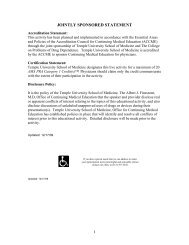
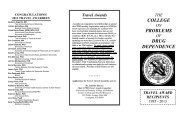
![2013SYMP AND WORKSHOP LIST[web]](https://img.yumpu.com/35325424/1/190x245/2013symp-and-workshop-listweb.jpg?quality=85)
